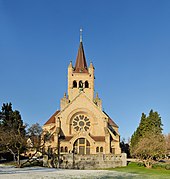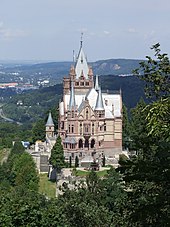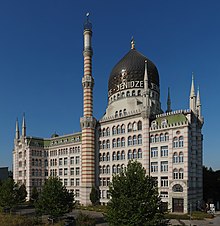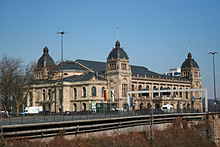historicism

In the history of art, the term historicism describes a phenomenon that was widespread in the 19th century and in some cases continued into the 20th century, in which - especially in architecture - older styles were used and some of them were combined.
Stylistic subspecies are u. a. the neo-Romanesque , neo-Gothic , neo-renaissance , the arched style and the neo-baroque . In its later phase, Art Nouveau , which historicism partially influenced , emerged in parallel . A counter-movement emerged at the beginning of the 20th century with reform architecture , which later led to classical modernism .
The most formative time for historicism extended from around 1850 to before the First World War . But even later, historicist motifs continued to have an impact ( neoclassicism , socialist classicism , architecture for the protection of the homeland ).
Style pluralism

In contrast to previous art historical epochs, a simultaneous stylistic pluralism is characteristic of historicism , which, however, is already heralded by the juxtaposition of classicism and romanticism at the turn of the 19th century.
In contrast to classicism, attempts were not only made to revive or copy the architecture of classical antiquity (as it was found in Greece and Rome ), but also to imitate architectural forms from other epochs, which were now regarded as equivalent. The Renaissance had also mainly drawn back on antiquity, but it also occasionally had targeted references to the High Middle Ages , for example in the architectural forms of the fortress houses and mansions .
Romanticism exerted a great influence, which helped develop a sense of the historically conditioned. Occasionally several styles were mixed in one building; these combinations are called eclecticism . Other buildings cite historical motifs, but cannot be assigned to any specific style.
First impulses from Great Britain
The first buildings in a non-classical style were built in Great Britain at the end of the 18th century . An early example is the Strawberry Hill villa , which Horace Walpole had built from 1749 to 1776 in the neo-Gothic style. The parliament building in London from 1835 is considered an early masterpiece of neo-Gothic architecture. Non-European architectural styles were soon copied: the Royal Pavilion (1815–1822) in Brighton is an early example of architecture based on Indian and Chinese models.
Period
Since historicism became more widespread in Central Europe from the 1850s and one of its original functions was to satisfy the representational needs of the bourgeoisie, who had become rich in the Wilhelminian era , it is sometimes referred to colloquially as the Wilhelminian style or Wilhelminian style architecture .
The end of historicism begins with Art Nouveau around 1895, which still uses ornaments, but without any historical reference. The same applies to Expressionism , which began in architecture shortly after the First World War. Beginning with the reform architecture after 1900 and increasingly from 1910, less elaborate, ultimately ornamentless or “ functionalist ” or “ constructivist ” architectural styles spread, which then became hegemonic in the 1920s (see New Building or New Objectivity ). This corresponds to a growing tendency of the style-forming layers to legitimize themselves less through references to their own history, but more and more through identification with modern technology. At this time, historicism came to an abrupt end in the losing states. In the victorious states, above all in the USA, or in countries that were not involved in the war, such as Spain, in addition to the New Buildings , historicism was still flourishing until the 1950s.
buildings

The industrial revolution of the 19th century required the construction of train stations, factories and water towers. To alleviate the housing shortage, multi-storey apartment buildings had to be built; the emerging and increasingly affluent bourgeoisie demanded villas and large city apartments in representative buildings.
The integration of new technologies in architecture and design was also important. The further development of steel production ( Bessemer process ) was decisive . The Crystal Palace, made entirely of cast iron and glass on the site of the London World's Fair of 1851, was considered revolutionary and groundbreaking for decades to come.
In some cases, different architectural styles were assigned different functions: churches were built in the Gothic or Romanesque style, banks and town houses in the Renaissance style (the great era of urban culture, especially in Italy), aristocratic palaces and especially theaters in the Baroque style , factory halls, however, mostly in the "English Tudor style " (with exposed brick facades).
Much emphasis was placed on representation, whereby functional aspects were occasionally subordinated (see University of Vienna ). This is one of the reasons why historicism was often criticized, especially in the middle of the 20th century . Above all, it was criticized that architectural ingredients such as columns, Medusa heads and acanthus leaves were used purely decorative to create a "historical atmosphere".
The facades of the buildings should not only reflect the social status of their residents in terms of their size and wealth, but also in the case of multi-family houses in their storey structure. For example, the first floor or the mezzanine floor was usually called “Bel Etage” and, with its particularly high ceilings and rich stucco decorations, was reserved for the wealthy bourgeoisie. Upward, the social position of the residents usually decreased with decreasing floor height . The top floor, with its often only hatch-like small windows, was usually inhabited by servants and other members of the lower social classes.
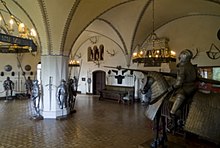
Historicism also played a major role in the interior, especially among the wealthy strata of the population, the nobility or the ruling royal houses . Whole castles or parts of them were rebuilt to reflect the zeitgeist. The ideals of the Middle Ages with chivalry and code of honor were upheld and found their expression in newly created knight halls and knightly suites.
In many newly created residential areas, backyards were created within the block perimeter development on former garden areas, and numerous additional quarters were often built in back buildings for the workers , often in close proximity to the workplaces and workshops. The overcrowded one-room apartments of the working class, with their often miserable and unhygienic living conditions, have been lamented by a number of reformers since the end of the 19th century. Among other things, they inspired the ideas of the garden city movement (see Ebenezer Howard ) and many a reform project in Germany.
A special feature of the architecture of this epoch are representative villa colonies based on an overall concept, such as the Marienthal colony in Hamburg and the well-preserved and exemplary villa colony of Lichterfelde-West in southwest Berlin (from 1860). In practice, the villa colonies were mixed residential areas because of the large number of staff required to manage the large houses. The ratio of the so-called “simple estates” to the “gentlemen”, for example in Lichterfelde-West in Berlin, was two to one. The villa colonies anticipated the idea of the "garden city" with their loosened up buildings, large gardens and avenues.
Style phases
In terms of style history, a distinction is made between romantic historicism (transitional styles from the 1770s, fully established from 1840s to 1870), strict historicism (1870–1890) and late historicism (after 1890). This distinction comes from Renate Wagner-Rieger .
The romantic historicism is characterized by a slow detachment from classicism. The preferred style is neo-gothic and neo-renaissance, but elements “unrelated to the style” are repeatedly combined, so that it is not a simple imitation of historical styles, but rather subjective interpretations. Elements from non-Western European styles ( e.g. Moorish or Byzantine ) are also combined. This was also expressed in a contemporary mocking poem against two prominent Viennese architects of this style, whose court opera had disappointed contemporaries: " Sicardsburg and van der Nüll / They both have no stuff / Gothic, Greek, Renaissance / They all don't."
The strict historicism on the other hand tries to combine art historically accurate "pure elements" of the last formal vocabulary. The subjectivism of romantic historicism is rejected; an attempt is made, on the other hand, to find a teachable and objectively correct style that is derived from the details of the form. The preferred point of reference is the architecture of the Renaissance (Neo-Renaissance).
In late historicism , the orientation towards the Renaissance is replaced by an orientation towards the Baroque style (Neo-Baroque). The strict orthography of the previous phase dissolves in favor of a freer interpretation of the decorative elements, which are no longer arranged strictly linearly. Bulging bay windows , risalits , domes and sweeping balconies are becoming popular. In general, there is a tendency towards exaggerated monumentality. Individual elements (such as the floral decorations) occasionally point to Art Nouveau .
These style phases can hardly be proven in the visual arts, even if painters such as Jean-Baptiste Carpeaux , Hendrik Leys , Hans Makart or Karl Theodor von Piloty took up historical forms of representation.
Styles of historicism
Hohenzollern Castle on the Swabian Alb , rebuilt in a neo-Gothic style between 1850 and 1867 by the Schinkel student, Stüler
District court Ilmenau , neoclassicism , built in 1914
Villa Cassalette in Aachen (today Suermondt-Ludwig-Museum ), built 1883–1888, example of New Mannerism (located between Neo-Renaissance and Neo-Baroque )
Semperoper in Dresden , built in representative neo-renaissance until 1878 , reconstructed until 1985 after being destroyed in the war
Comedy theater in Budapest , built in 1900 in neo -baroque style
Church of the Nativity of John the Baptist near Leskovac in the style of Neo-Byzantine architecture , Grigorije Samojlov 1938
Neo-Romanesque
The neo-Romanesque or neo-Romanesque originated when, after 1870, the “French-inspired” style of neo-Gothic fell into disrepute and the “more German” Romanesque was propagated instead. Neo-Romanesque was considered a “national architectural style”, especially in Protestant Germany, and was mandatory for Protestant church buildings for decades according to the Wiesbaden program . In addition to the Romanesque style, the style also draws on Byzantine forms.
The style was also formative in the reconstruction and the romanticizing new construction of castles or castle-like buildings, e.g. B. at Dankwarderode Castle in Braunschweig , Neuschwanstein Castle and at Drachenburg Castle . Public buildings were also often built in the neo-Romanesque style, a representative example is the Prussian government building in Koblenz .
Neo-Gothic

The earliest and most formative historicist style is neo-Gothic or neo-Gothic . Gothic forms were rediscovered as early as the end of the 18th century, for example at the Nauener Tor in Potsdam from 1755. A little later, among other things, the "regotization" of Viennese churches by Johann Ferdinand Hetzendorf von Hohenberg around 1805, which was, however, still owed to a classical taste of the time, so that much of the authentic Gothic was lost. In Great Britain in particular , neo-Gothic became the defining style of the industrial age .
In the 1840s, the Gothic was increasingly perceived as a symbol of an architecture of civil liberty. The most important representative in Austria was Friedrich von Schmidt , in Switzerland Ferdinand Stadler . A recently carefully restored testimony to the neo-Gothic can be found in the center of Chemnitz : Villa Zimmermann. We owe the completion of some Gothic cathedrals that were unfinished in the Middle Ages to the Neo- Gothic , and they were also often used for representative bourgeois buildings (town halls, etc.), as the Gothic period (late Middle Ages) was associated with the heyday of the city republics.
Neo-renaissance
An important historical architectural style is the neo-renaissance or neo-renaissance . Since the Renaissance was seen primarily as a heyday of the arts, the Neo-Renaissance was the preferred style for theaters, opera houses and museums.
The style became formative in England and France at the end of the 19th century. There are also numerous representative examples in Germany, such as the Schwerin Palace designed by four architects , Leo von Klenze's Palais Leuchtenberg , the Berlin Reichstag (with neo-baroque elements), and buildings by the Dresden Semper-Nicolai School . In Austria the Vienna State Opera should be mentioned.
Newmanism
Neumanierism , also stylized mannerism , was introduced and defined as a stylistic term by Albrecht Mann in 1998 . The Napoléon III. The corner pavilions commissioned in the Louvre courtyard were the first construction measures of this type, followed by the Opéra Garnier and the residential buildings on the new boulevards . The style characteristics are: all-round clear demarcation of the facade, "antique-classic decorative shapes, strongly plastic surface, overloading with formal elements (horror vacui = fear of empty space)." founded the Neomanierism . Since the execution is stylized, this art style can be described as stylized mannerism . In the course of European expansion, Neumanierism became the form of expression of the Wilhelmine era and the architectural style of the Berlin Reichstag building . A notable example is the Aachen Villa Cassalette and the Opéra de Monaco .
Neo-baroque
The neo-baroque or neo- baroque emerged increasingly from 1890, especially in late historicism. The Baroque era , the absolutism of the nobility , was considered to be the height of secular monarchical power, which is why state buildings were often built in this style.
The neo-baroque style finds its climax in the Paris Opera , the Brussels Palace of Justice as well as the New Hofburg in Vienna and in Herrenchiemsee Palace in Bavaria .
Neo-Rococo
Neo-Rococo or Neo- Rococo appeared less often in the construction industry than in the interior design of castles and town houses. In the second third of the 19th century, for example, Schönbrunn , the Vienna Hofburg and the Albertina were furnished with interior furnishings based on the Rococo , for which authentic Rococo was sometimes sacrificed. It was mainly furniture in the Austrian national colors white and red (decorated with a little gold). Examples of Neo-Rococo are also Linderhof Palace and the Herner Seepavillon . The Neo-Rococo also developed in painting in the 19th century. After rather isolated Rococo receptions around 1840, there was an ongoing Rococo fashion around 1860, which was developed by painters such as James Moulton Burfield , Otto Erdmann , Louis von Hagn , Karl Hoff , Ludwig Knaus , August Hermann Knoop , Heinrich Lossow , Georg Reimer , Joseph Scheurenberg and Benjamin Vautier were served.
Neo-Byzantism
In Russia, Yugoslavia, Serbia, Greece, Bulgaria, but also in France, England, Austria-Hungary, Great Britain, the USA and Germany, in the 19th and sometimes in the 20th century, in addition to sacred buildings, representative public buildings, the style and spatial elements of the Byzantine architecture and art quote. Via Teophil Hansen and his followers, the Neo-Byzantine style had also shaped numerous public buildings and churches in Central Europe. One of the earliest buildings is the court church built by Leo von Klenze for Ludwig I in the Munich residence and St. Boniface . Ludwig II also had the large residence hall in Neuschwanstein Castle built as a neo-Byzantine throne room. In the interior decoration, mosaic and marble decorations emphasized the representative characteristics of the buildings. The style was particularly influential in Russia and Yugoslavia (especially in Serbia), for which a building in the national style was required for the construction of large churches. David Grimm's and Vasily Kosyakov's church buildings with a central room with four pendent apses attached to the Hagia Sophia and a bell tower built above the narthex near Kosyakov were widely imitated and were the standard program for church buildings in the Russian Empire. Grimm built the Tbilisi Military Church in Tbilisi , Kosyakov the St. Petersburg Cathedral (1888–1898), the Vladimir Cathedral in Astrakhan and the Nicholas Naval Cathedral in Kronstadt . An early example is the Cathedral of Christ the Savior in Moscow. The Alexander Nevsky Cathedral in Sofia is also indebted to Russian models and built by Russian architects . The style had a second bloom in the interwar period in the Kingdom of Yugoslavia, where Alexander I. Karađorđević was their greatest sponsor. In addition to the national project in the St. Sava Cathedral, Aleksandar Deroko , Momir Korunović and Grigorije Samojlov in particular came closest to the issue of a distinctly national architecture and independent artistic vision.
In Great Britain the Westminster Cathedral , in France the Basilica Sacré-Cœur de Montmartre and in the USA the Basilica of the National Shrine of the Immaculate Conception and the Cathedral Basilica in St. Louis are noteworthy.
Orientalizing historicism
A rather seldom used variant of historicism was the erection of buildings in the oriental style. It was mainly used in buildings which, according to the understanding of the time, had a close relationship with the Orient . Buildings of companies that were active in the oriental trade or produced goods associated with the Orient, such as the Yenidze tobacco factory in Dresden, and with certain variants of the architecture of the Freemasons , as developed especially in the USA. The “Moorish” style was often used for synagogues , striking examples are the Great Synagogue in Budapest and the New Synagogue in Berlin. Examples of the use of this style in the non-religious area include: the Arsenal in Vienna, the so-called Zacherlfabrik in Vienna- Döbling , the Wilhelma park in Stuttgart and the Villa Crespi in Orta San Giulio . But even in the baroque era there were buildings such as the “mosque” in the park of Schwetzingen Palace and in other palace gardens.
The Royal Pavilion Brighton in England is an orientalizing palace building , which was created until 1822 as an exotic mixture of Middle Eastern, Indian and Chinese style motifs. Mogul style elements were often used in public construction projects in British India , for example the museum in Lahore or the Gateway of India in Mumbai .
Neo-historicism
After the end of historicism, as it was common in the 19th century, there were other historicizing movements in architecture in the 20th century , such as neoclassicism , socialist classicism , the Heimatstil or Heimatschutz architecture . Since the 1980s, neo-historicism , which seeks to regain the atmospheric qualities of historical building, has been increasingly widespread .
Historicist architecture in Central Europe
Germany
The Nauener Tor in Potsdam from 1755 is considered to be the first historical building on the European continent , which can be assigned to the neo-Gothic .
In Germany, especially in Prussia , Karl Friedrich Schinkel initially developed a pronounced classicism . Stylistic mixed forms began in the 1830s.
A residential and commercial building at the beginning of the former Kaiser-Wilhelm-Strasse in Berlin-Mitte (1887 by Cremer & Wolffenstein ) is considered the initial building of the German, “Wilhelmine” Neo-Baroque .

Ensembles that have been largely spared from the war (and the destruction of the post-war period) and are unusually closed can be found, for example, in Berlin, where the "Wilhelminian-style buildings" that have been preserved are the most numerous - especially the "working-class quarters" of Prenzlauer Berg , Friedrichshain , Neukölln and large parts of Kreuzberg , but also representative streets around the Kurfürstendamm , Hamburg , Bonn's Südstadt , which with the Weststadt and Nordstadt is one of the largest coherent "Wilhelminian-style quarters " in Germany, the Nordstadt and the Briller district in Wuppertal, Chemnitz (e.g. Kaßberg and Schloßchemnitz ), Görlitz , Fürth , the Erfurt suburbs , Leipzig (in most parts of the city there are still high-quality, closed historicist buildings, e.g. the Waldstrasse district and the music district ), Dresden, which, together with the " Äußere Neustadt ", is a large "Gründerzeitviertel" has to show, Munich, where you can mainly find in the districts Altstadt-Lehel and Neuhausen-Nymphenburg finds many “Wilhelminian-style” buildings, Hanover List , the eastern ring area in Braunschweig and also in Strasbourg , which has an extensive planned new town from the imperial era. The inner city of Halle is considered the largest contiguous residential area of this era. A considerable number of Wilhelminian-style houses, some in extensive ensembles ( gardens behind the fortress and St. Johannis (Nuremberg) ), are also found in Nuremberg and Fürth, despite considerable war losses. In Nuremberg there was a special feature of the Nuremberg style , a special form of historicism typical of the area. Along with Braunschweig and Berlin, Wiesbaden is the only city that can boast an almost completely preserved city ring. The Kaiser-Friedrich-Ring on the Wiesbadener Ringstrasse is 100 percent identical to the situation in 1907. The Wiehre in Freiburg im Breisgau as well as the west of Bielefeld and the Musikerviertel also have a rich structure .
Even in eastern Germany, buildings from the early days can still be found in numerous cities despite the extensive bombing in World War II . Cities such as Rostock (villa district south of the city center and tenements west of the city center), Magdeburg (area around Hasselbachplatz ), Chemnitz , Dresden ( Äußere Neustadt ) and Dessau (around Heinrich-Heine-Straße) have the same characteristics as all East German cities worst hit by bombing raids, still preserved “Wilhelminian style quarters” or “streets”. Most of them have been renovated. In recent years, numerous monuments of this era have been demolished in numerous East German cities as part of the Urban Redevelopment East Program against resistance from monument preservers and the population, for example 446 buildings that are actually listed buildings in Leipzig between 1990 and 2006. Chemnitz is currently experiencing massive developments Interventions in its founding heritage. Significant losses of “Wilhelminian” buildings are to be lamented in numerous West German cities such as Cologne , Kassel , Mannheim , Ulm , Nuremberg , Würzburg , Braunschweig , Koblenz and in the entire Ruhr area .
Other historic buildings in Germany:
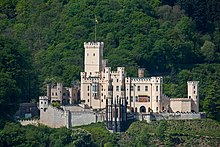
- Old Opera in Frankfurt
- Berlin Cathedral
- Evangelical City Church (Wanfried)
- Feldherrnhalle in Munich
- Picture gallery Dresden
- Hamburg Music Hall
- Landsberg am Lech mother tower
- New Town Hall Hanover
- New City Hall Leipzig
- Hamburg City Hall
- Prinz-Max-Palais in Karlsruhe
- Ravensberger spinning mill in Bielefeld
- Imperial Court Building in Leipzig
- Reichstag building in Berlin
- Drachenburg Castle near Königswinter
- Marienburg Castle near Pattensen
- Neuschwanstein Castle near Füssen
- Stolzenfels Castle near Koblenz
- Schwerin Castle
- Semperoper in Dresden
- Historic town hall Wuppertal
- St. Luke Church in Munich
- Leipzig University Library
- St. Paul in Munich

After the First World War, historicism was no longer valued. The use of older styles was interpreted as a lack of independence. This low esteem led to a great loss of substance in Germany during and after the Second World War . Numerous structures were lost in the bombing war, but the relatively new structure and good workmanship meant that many damaged buildings could also be repaired. However, they were often not restored, but deliberately demolished and replaced by new buildings or modernized, i.e. robbed of their decoration ( removal of stucco ). However, this later changed again. B. the extensive restoration of the Imperial Court in Leipzig proves.
The elaborate interior of many Catholic neo-Gothic churches was often removed and destroyed in the course of the redesign according to the Second Vatican Council , because their style was dismissed as carpenter's Gothic.
The “Wilhelminian” villa colonies, which were created from the mid-nineteenth century, are a specialty . While the construction areas were planned and developed according to classic urban planning aspects, the individual building owners were given only a few urban planning specifications. Accordingly, areas arose with the most diverse forms of architecture of historicism that were tailored to the representational demands of the Wilhelminian bourgeoisie . The villa colonies in Lichterfelde near Berlin, which emerged from around 1850, were outstanding examples and models for many later systems . Lichterfelde-West has been largely preserved to this day and, after years of building rental apartments on plots of destroyed villas, is now largely a listed building . There are also extensive old villa colonies in Bonn-Bad-Godesberg , Hamburg-Marienthal, Wiesbaden , Wuppertal-Elberfeld , Weimar, Eisenach and Potsdam, and in almost all large cities there are still smaller quarters or at least remnants of them. The Dresden villas or the Radebeul villa districts Oberlößnitz and Niederlößnitz in the west of Dresden are also exemplary .
On the housing market, the houses of the late historicism are again in great demand and the real estate industry likes to market them as an Art Nouveau house , even if the offered property usually has no or hardly any features of Art Nouveau. In some German cities there are still large closed areas of this type, for example large and representative apartment buildings in Hamburg-Eppendorf and villas around the Outer Alster .
Countries of the Danube Monarchy
Austria
As Viennese historicism, historicism is still the dominant style in Vienna , and entire city districts were built according to its model. There were two high points in construction activity: the construction of the Ringstrasse , which began in the 1860s and shaped the Ringstrasse style , and the regulation of the Vienna River around 1900, which, however, was also partially built in Art Nouveau style. Outside of Vienna there are only larger districts characterized by historicism in Graz and Linz .
An important direction of late historicism in Austria, which was primarily used in the construction of villas, hotels and sanatoriums, is the Heimatstil , which is also represented in Switzerland . This style phenomenon was also referred to as the Tyrolean house, fretwork, Swiss house, or half-timbered style, or divided into these groups according to individual characteristics. Buildings worth seeing can mainly be found in the health resorts of the Austro-Hungarian monarchy, such as Bad Ischl or Reichenau an der Rax and along the southern railway line. The Semmering with its villa colony and the Südbahnhotel should be mentioned here . Analogous to the large and luxurious hotel buildings in Austria around 1900, the spa facilities were also designed in the local style. The famous Austrian lung sanatoriums in the eastern Alpine foothills, such as the Henriette Weiss sanatorium, the Hochegg sanatorium or the Wienerwald sanatorium, were all built in the Heimat style.
Viennese historicism lived on in the Danube Monarchy , where it became, so to speak, the “imperial style” until 1914 ( Prague , Laibach , Agram etc.). Around 1900, Neo-Baroque was the most common architectural style with a "patriotic" connotation: it was supposed to be a link (under the label Maria Theresa style ) to the 18th century and its cultural bloom in Austria.
Here, as in other countries, numerous castles, such as Liechtenstein and Kreuzenstein, were reborn as romantic ideas .
Army History Museum , neo-Byzantine , neo-Gothic , 1850–1856
Vienna Votive Church , neo-Gothic 1856–1879
Parliament , neoclassical (also neo-Hellenic ) 1873–1884
Hofburg ( New Castle ), neo-baroque from 1869
Südbahnhotel Semmering, Heimatstil 1881
Herz-Jesu-Kirche in Graz, neo-Gothic
Gustav Adolf Church in Vienna, neo-Romanesque, Islamic and neo-Byzantine elements; consecrated 1849
Hungary


In Hungary and especially in Budapest , which was growing rapidly at the time , numerous buildings were developed in the historicist style. One of the most representative and largest neo-Gothic buildings is the Hungarian parliament building . The neo-Gothic design continues inside with historicist paintings, sculptures and windows that trace Hungarian history.
Andrássy út (Andrássy Street) is a historical ensemble, mainly in the neo-renaissance style .
In the building complex of Vajdahunyad Castle you can find almost every architectural style of historicism in a smaller space, from the Romanesque style to the Gothic and Renaissance to the Baroque.
Switzerland
In Switzerland, too, historicism prevailed for a few decades, which the Swiss National Museum in Zurich in particular stands for. In the young federal state at the end of the 19th century, going back to one's own history was of great importance. The return to history led to the use of historical style elements in architecture and their amalgamation to form a new whole.
- Federal Palace in Bern, 1852–1902
- Elisabethenkirche in Basel, 1857–1864
- Town house in Winterthur, 1865–1869
- Zurich main station , 1870–1871
- Historical Museum Bern , 1892–1894
- Enge Church in Zurich, 1892–1894
- Tonhalle in Zurich, 1893–1895 (partly demolished in 1938)
- Swiss National Museum in Zurich, 1897
- Pauluskirche in Basel, 1898–1901
- Hotel Waldhaus 1908, Sils-Maria
- Suvretta House 1912, St. Moritz
Historicist architects (selection)
- Ignác Alpár
- Ludwig Becker
- Joseph Cades
- Carl Wilhelm von Doderer
- Georg von Dollmann
- Heinrich von Ferstel
- Friedrich von Gärtner
- Felix Genzmer
- Ernst Giese
- Oswald Haenel
- Theophil Freiherr von Hansen
- Max Hasak
- Conrad Wilhelm Hase
- Carl von Hasenauer
- Georg von Hauberrisser
- Alajos Hauszmann
- Christoph Hehl
- Ludwig Hofmann
- Heinrich Huebsch
- Carl Beetle
- Hugo light
- Josef Mocker
- Heinrich Moldenschardt
- Hermann Nicolai
- Eduard van der Nüll
- Edwin Oppler
- Hermann Otto Plum
- Max Pommer
- Julius Carl Raschdorff
- Wilhelm Rincklake
- Arwed Rossbach
- Adolf Schill
- Friedrich von Schmidt
- Franz Heinrich Schwechten
- George Gilbert Scott
- Gabriel von Seidl
- Gottfried Semper
- August Sicard of Sicardsburg
- Max Spitta
- Ferdinand Stadler
- Vincenz Statz
- Friedrich von Thiersch
- Georg Gottlob Thunderstorm
- Eugène Viollet-le-Duc
- Paul Wallot
- Gustav Albert Wegmann
- Wilhelm Wickop
- Ernst Ziller
- The Ziller brothers
- Ernst Friedrich Zwirner
research
The scientific recognition and research of the architecture and art of historicism in the German-speaking area only took place after some time from the late 1960s onwards. Despite the intermittent increase in research on historicism, the epoch is still underrepresented in scientific discourse compared to others. In 2018, the non-profit association of the German Research Center for Historicism was founded in Wiesbaden with the aim of promoting and strengthening research on historicism. The association and its scientific program were presented to the public for the first time at the 35th German Art History Conference in Göttingen in 2019.
literature
- Dieter Dolgner: Historicism - German architecture 1815-1900. (= German architecture ). Seemann, Leipzig 1993, ISBN 3-363-00583-0 .
- Hans Gerhard Evers : From Historicism to Functionalism. (= Art of the World. The Cultures of the Occident ). Holle Verlag, Baden-Baden 1967, DNB 573059802 . (1976, ISBN 3-87355-121-7 ).
- Hans Gerhard Evers: Attempt to save the honor of historicism. In: The work of art. 16, 1963, pp. 2-4.
- Hans Gerhard Evers: Historicism and fine arts. In: Historicism and fine arts. Lectures and discussions in October 1963 in Munich and Anif Castle. (= Studies on 19th Century Art. 1). Munich 1965, pp. 25-42. (Reprinted in: Schriften. Technische Hochschule Darmstadt, 1975. Collection and reprint of important articles by Hans Gerhard Evers).
- Nikolas Werner Jacobs: The “City of Historicism” - a special case. On the reception history of historicism in Germany using the example of Wiesbaden. In: Tobias Möllmer (Ed.): Style and character. Contributions to the history of architecture and the preservation of monuments in the 19th century. Festschrift for the 75th birthday of Wolfgang Brönner . Basel 2015, pp. 372–385.
- Eva-Maria Landwehr: Art of Historicism. Böhlau Verlag ( UTB ), Cologne / Weimar / Vienna 2012, ISBN 978-3-8252-3645-8 .
- Klaus F. Müller: Park and Villa Haas - Historicism, Art and Lifestyle. Verlag Edition Winterwork, 2012, ISBN 978-3-86468-160-8 .
- Gottfried Kiesow : The misunderstood century - Historicism using the example of Wiesbaden. German Foundation for Monument Protection, Bonn 2004.
Web links
- Klaus Graf: Retrospective tendencies in the fine arts. Selected bibliography. ( Memento from August 20, 2003 in the web archive archive.today )
- Internet presence of the Friends of the German Research Center for Historicism eV
- Historismus.Net - Internet portal with a database on works and artists of historicism
- André Meyer: Historicism (art). In: Historical Lexicon of Switzerland .
Individual evidence
- ^ Albrecht Mann: Our Aachen today. Aachen's architecture in the style change of the 20th century. Helios, Aachen / Belgium 1998, p. 11. stylized mannerism Bez. V. RMS.
- ↑ Babette Marie Warncke: Rococo fashion. Rococo reception in 19th century German painting (PDF; 54.4 MB). Dissertation at the Albert-Ludwigs-Universität, Freiburg im Breisgau, 1995.
- ↑ Aleksandar Kadijević: Between Artistic Nostalgia and Civilisational Utopia: Byzantine Reminiscences in Serbian Architecture of the 20th Century. In: Lidija Merenik, Vladimir Simić, Igor Borozan (eds.): Imagining the past: the reception of the Middle Ages in Serbian art from the 18th to the 21st century. (= Byzantine heritage and Serbian art. III ). The Serbian National Committee of Byzantine Studies, PE Službeni glasnik, Institute for Byzantine Studies, Serbian Academy of Sciences and Arts, Belgrad 2016, p. 177. (Academia: PDF)
- ^ Saxon newspaper. July 8, 2006.
- ↑ Free press. January 8, 2009.
- ↑ Nikolas Werner Jacobs: The "City of Historicism" - a special case. On the reception history of historicism in Germany using the example of Wiesbaden. In: Tobias Möllmer (Ed.): Style and character. Contributions to the history of architecture and the preservation of monuments in the 19th century. Festschrift for the 75th birthday of Wolfgang Brönner . Basel 2015, pp. 372–174.
- ↑ Gottfried Kiesow: The misunderstood century - historicism using the example of Wiesbaden. German Foundation for Monument Protection, Bonn 2004, passim.
- ^ Wiesbadener Kurier: Wiesbaden should become the center of historicism
- ↑ Program of the XXXV. German Art Historians' Day in Göttingen: Historicism - Any Questions? Two Wiesbaden initiatives “on things” from an epoch that is only apparently “explored”
